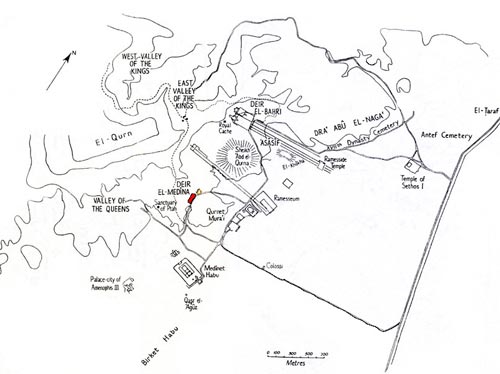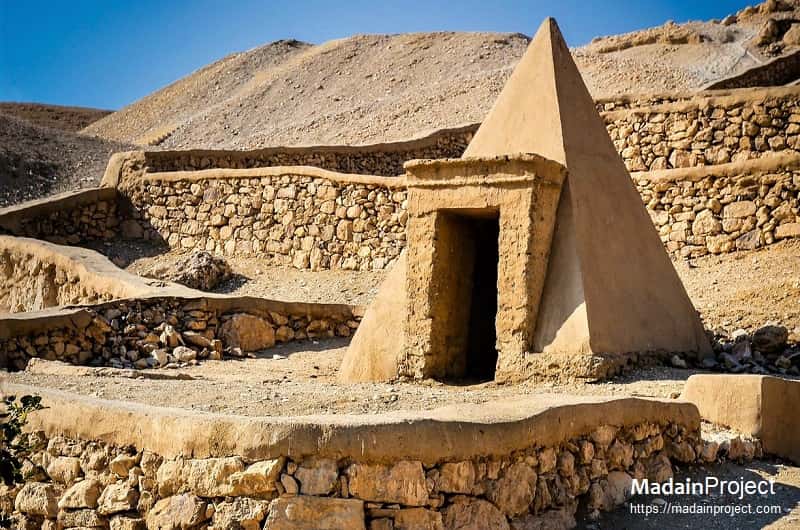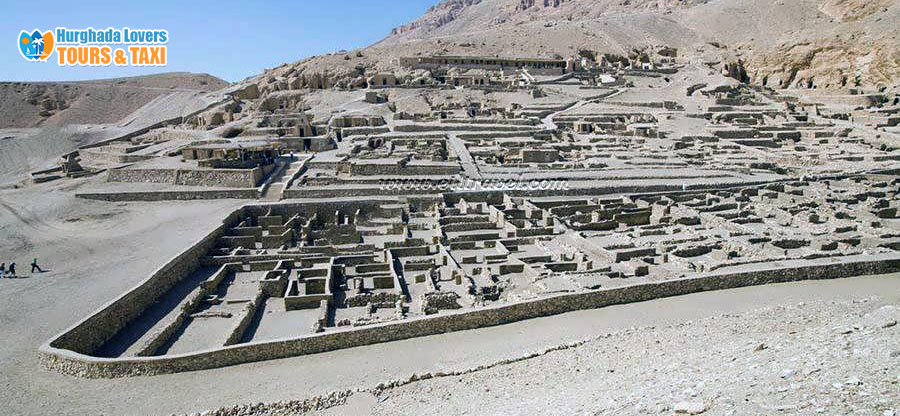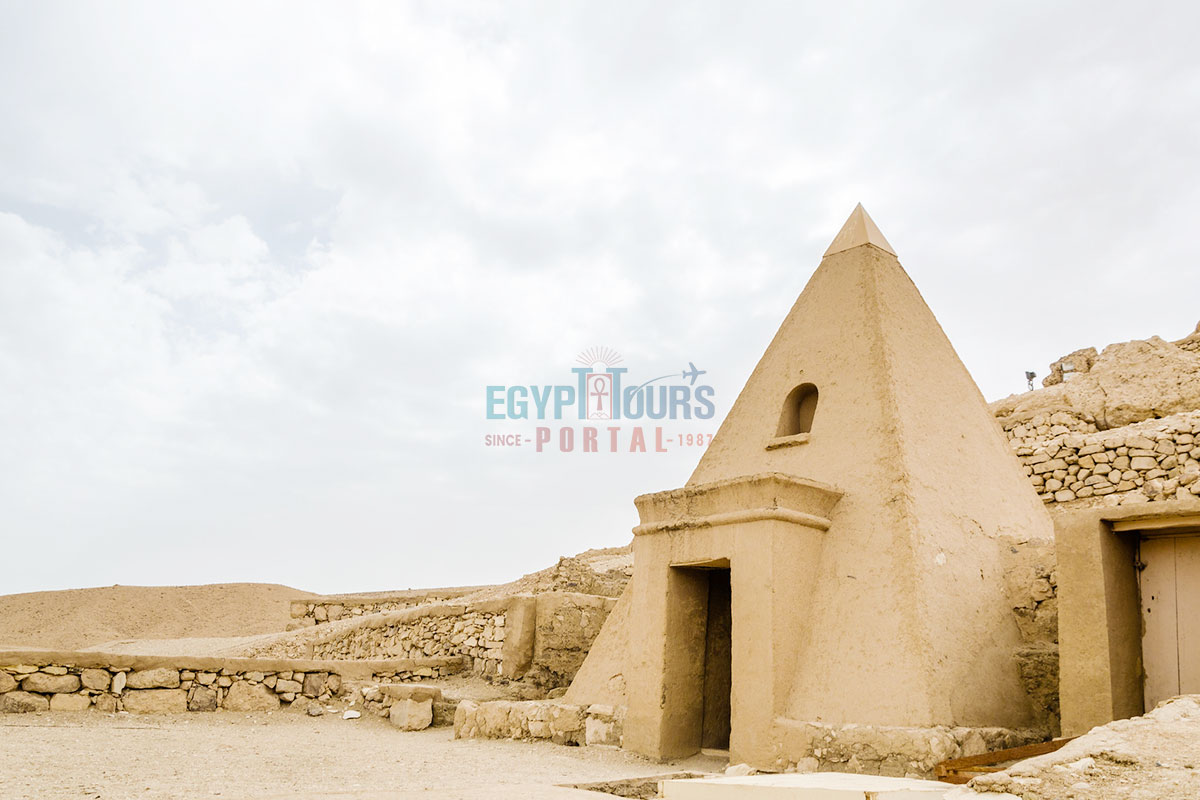Deir El-Medina: A Glimpse into Ancient Egyptian Life
If you are fascinated by ancient civilizations, then Deir El-Medina is a place you must explore. This ancient Egyptian village offers a unique glimpse into the daily life of the people who built the magnificent pyramids and temples we admire today.
A brief overview of Deir El-Medina and its significance in Ancient Egyptian history
Deir El-Medina, located on the west bank of the Nile near Luxor, was a village that housed skilled craftsmen and artisans who worked on the tombs in the nearby Valley of the Kings. It was active during the New Kingdom period, from 1550 to 1070 BCE.
What makes Deir El-Medina so significant is that it provides valuable insights into the lives of ordinary Egyptians during this time. Unlike other ancient sites that focus on royalty and the elite, Deir El-Medina offers a glimpse into the common people's daily routines, social structure, and religious practices.
The village is well-preserved, with its houses, workshops, and even personal belongings intact. You can explore the narrow streets, visit the homes of the artisans, and see firsthand how they lived and worked. The walls of these houses are adorned with beautiful paintings depicting scenes from everyday life.
In addition to its residential area, Deir El-Medina also had a temple dedicated to Hathor, the goddess of love and beauty. This temple played an important role in the spiritual lives of the villagers.
Visiting Deir El-Medina allows you to step back in time and immerse yourself in the world of ancient Egypt. It is a unique experience that will deepen your understanding of this remarkable civilization.

Location and History
The geographical location of Deir El-Medina and its historical background
If you're fascinated by ancient civilizations, visiting Deir El-Medina is a must. Located on the west bank of the Nile River in Egypt, this archaeological site offers a unique glimpse into the daily lives of ancient Egyptians.
Deir El-Medina, also known as "The Valley of the Workers," was a small village that served as the home for the artisans and craftsmen who built and decorated the tombs in the nearby Valley of the Kings. It was inhabited during the New Kingdom period, from around 1550 BCE to 1080 BCE.
The village was strategically positioned in a secluded valley, surrounded by cliffs, which protected it from potential tomb robbers. Its location also made it easier for the workers to access the nearby tombs they were working on.
The inhabitants of Deir El-Medina were highly skilled craftsmen, including painters, sculptors, and architects. They lived in modest houses made of mud bricks and had communal facilities, such as a temple, cemetery, and even a school for their children.
One of the unique aspects of Deir El-Medina is the abundance of written records found at the site. These include letters, legal documents, and even personal diaries that provide valuable insights into the daily lives and concerns of the villagers.
Visiting Deir El-Medina allows you to explore the remains of this ancient village and gain a deeper understanding of how these skilled workers lived and contributed to the grandeur of ancient Egyptian civilization. So, if you're ever in Egypt, don't miss out on this fascinating glimpse into ancient Egyptian life.

Daily Life in Deir El-Medina
Insight into the daily routines, social structure, and roles of the people living in Deir El-Medina
If you've ever wondered what life was like in ancient Egypt, a visit to Deir El-Medina will provide a fascinating glimpse into the daily routines, social structure, and roles of the people who lived there.
Deir El-Medina was a village located on the west bank of the Nile, near modern-day Luxor. It was home to the artisans and craftsmen who built and decorated the tombs in the nearby Valley of the Kings. The village was inhabited during the New Kingdom period, from around 1550 to 1070 BCE.
The people of Deir El-Medina lived in tightly-knit communities and had a unique social structure. The village was divided into sections based on the craftsmen's skills and hierarchies. The workers were organized into teams, each led by a foreman. They worked together on various projects, such as tomb construction and decoration.
The daily routines of the villagers were centred around their work. They would wake up early and gather at the workshop to receive instructions. The craftsmen then proceeded to their assigned tasks, using their skills to create intricate artwork and hieroglyphs.
In addition to their work, the people of Deir El-Medina also had personal lives. They had families and homes within the village. Archaeological evidence suggests they enjoyed leisure activities such as music, dancing, and board games.
Visiting Deir El-Medina allows you to explore the remains of this ancient village and gain insight into how these skilled craftsmen lived and worked. It provides a unique opportunity to step back in time and experience a slice of ancient Egyptian life.
So, if you're interested in ancient history and want to learn more about the daily lives of the people who built the grand tombs of the pharaohs, a visit to Deir El-Medina is a must.

The Tomb Builders
The important role of the artisans and craftsmen in constructing the tombs of Pharaohs
If you ever find yourself fascinated by ancient Egyptian history, you must explore the intriguing world of Deir El-Medina. This ancient village, located on the west bank of the Nile near Luxor, offers a unique glimpse into the daily lives of the artisans and craftsmen who built the tombs of pharaohs.
In ancient Egypt, constructing a pharaoh's tomb was no ordinary task. It required meticulous planning, skilled craftsmanship, and unwavering dedication. The artisans and craftsmen of Deir El-Medina were entrusted with this monumental responsibility.
These skilled workers were responsible for building the tombs and creating intricate decorations and paintings that adorned the walls. They were true masters of their craft, using their expertise to bring the pharaohs' final resting places to life.
The village of Deir El-Medina was home to these talented individuals and their families. They lived in a close-knit community, isolated from the rest of society to ensure the secrecy and security of their work. Their dedication and commitment to their craft were unparalleled.
The tombs they constructed were not just simple burial chambers but architectural marvels filled with intricate details and symbolic representations. Each tomb was unique, reflecting the individuality and status of the pharaoh it was built for.
Exploring Deir El-Medina allows us to appreciate these ancient craftsmen's incredible skill and artistry. It offers a rare opportunity to witness firsthand how they transformed stone into magnificent structures that still stand today as a testament to their talent.
Visiting this ancient village is like stepping back in time, immersing yourself in the world of these skilled artisans. It is an experience that will leave you in awe of their craftsmanship and give you a deeper understanding of the rich history of ancient Egypt.

Architecture and Structures
Description of the unique architecture and structures found in Deir El-Medina
If you are fascinated by ancient civilizations and want to immerse yourself in the rich history of Egypt, a visit to Deir El-Medina is a must.
Deir El-Medina, located on the west bank of the Nile River near Luxor, was a village that housed the skilled workers who built and decorated the tombs in the nearby Valley of the Kings. The village was inhabited during the New Kingdom period, approximately from the 16th century BC to the 11th century BC.
One of the most remarkable aspects of Deir El-Medina is its unique architecture. The houses in the village were built using mud brick, a common construction material during that time. The houses were typically small and compact, with one or two rooms. The walls were decorated with colourful paintings depicting scenes from everyday life, religious rituals, and mythological stories.
In addition to the houses, other structures in Deir El-Medina played important roles in the daily lives of its inhabitants. These included a temple dedicated to the goddess Hathor, who was believed to protect the village and its workers. The temple featured beautifully carved reliefs and statues.
Another notable structure in Deir El-Medina is the communal tomb, where the workers were buried. These tombs were often decorated with scenes from the afterlife and offerings for the deceased.
Visiting Deir El-Medina offers a unique glimpse into ancient Egyptian life. The architecture and structures found in this village provide valuable insights into its inhabitants' daily lives, beliefs, and artistic skills. It is truly a remarkable place that history enthusiasts should not miss.

Religious Practices and Beliefs
Exploration of the religious practices and beliefs of the people in Deir El-Medina
If you are fascinated by ancient civilizations and want to delve into the religious practices and beliefs of the people in Deir El-Medina, you're in for a treat! This archaeological site in ancient Egypt offers a glimpse into the daily lives of the craftsmen and their families who lived there over 3,000 years ago.
Religion played a significant role in the people's lives in Deir El-Medina. They worshipped various gods and goddesses, with Amun one of the most prominent deities. The inhabitants believed Amun was responsible for their well-being, prosperity, and protection. They would often make offerings to Amun in hopes of gaining his favour.
The people of Deir El-Medina also believed in an afterlife. They constructed tombs for themselves and their loved ones, filled with provisions and objects they believed would be needed in the next life. These tombs were adorned with intricate paintings depicting scenes from everyday life, religious rituals, and mythical stories.
In addition to their religious practices, the people of Deir El-Medina also strongly believed in magic and spells. They believed these spells could protect them from evil spirits, illness, and misfortune. Magical amulets were commonly worn as a form of protection.
Exploring the religious practices and beliefs of the people in Deir El-Medina provides a fascinating insight into ancient Egyptian culture. It allows us to understand how religion permeated every aspect of their lives and shaped their worldview. So, if you're interested in ancient history and want to learn more about this captivating civilization, visit Deir El-Medina!

Art and Decoration
Discussion on the artistic expressions and decorations found in Deir El-Medina
If you are fascinated by ancient civilizations and want to catch a glimpse into the daily lives of the ancient Egyptians, a visit to Deir El-Medina is a must!
Deir El-Medina, located on the west bank of the Nile River near Luxor, was a village that housed the artisans and craftsmen who built and decorated the tombs of the pharaohs in the nearby Valley of the Kings. The village provides a unique insight into ancient Egyptian life's artistic expressions and decorations.
One of the most striking features of Deir El-Medina is the abundance of beautifully painted tombs. These tombs depict scenes from everyday life, religious rituals, and mythological stories. The vivid colours and intricate details showcase the skill and craftsmanship of the artisans who created them.
The walls of the tombs are adorned with hieroglyphic inscriptions, providing valuable information about the beliefs, customs, and social structure of ancient Egypt. These inscriptions give us a glimpse into their religious practices, burial rituals, and even personal stories of the individuals buried in these tombs.
In addition to the tombs, Deir El-Medina also boasts well-preserved houses that provide insights into the villagers' daily lives. The walls of these houses are adorned with paintings depicting scenes of family life, agricultural activities, and even entertainment.
The artistic expressions and decorations found in Deir El-Medina offer a unique window into ancient Egyptian life. They allow us to appreciate the skill and creativity of these ancient artisans while providing valuable insights into their beliefs, customs, and daily routines. A visit to Deir El-Medina is an enriching experience for anyone interested in ancient history and art.

Discoveries and Excavations
If you are fascinated by ancient civilizations, then Deir El-Medina is a must-visit destination. This ancient Egyptian village offers a unique glimpse into the daily lives of the people who built and decorated the tombs in the Valley of the Kings and Queens.
Highlights of significant archaeological discoveries and excavations in Deir El-Medina
-
The Village Layout: Excavations have revealed a well-preserved village layout, complete with houses, workshops, and even a small temple. This provides valuable insights into how the community was organized and how the workers lived and interacted with each other.
-
The Tombs: The village was home to skilled craftsmen who worked on the tombs of pharaohs and nobles. Excavations have uncovered beautifully decorated tombs that showcase the exceptional artistry of these craftsmen. The walls are adorned with intricate paintings depicting scenes from everyday life, religious rituals, and mythology.
-
The Ostraca: Thousands of ostraca (potsherds) have been discovered in Deir El-Medina. These inscribed pottery pieces provide a wealth of information about the villagers' daily lives, including their work schedules, personal matters, and even complaints about their neighbours.
-
The Papyri: Besides ostraca, a collection of papyri has been found in Deir El-Medina. These ancient documents offer detailed accounts of legal disputes, administrative matters, and correspondence between villagers and officials.
-
The Temple of Hathor: The village is home to a small temple dedicated to Hathor, the goddess of love and joy. Excavations have revealed beautifully carved reliefs depicting various religious scenes and rituals.
Visiting Deir El-Medina is like stepping back in time and immersing yourself in the daily lives of ancient Egyptians. The discoveries and excavations in this unique village provide invaluable insights into their culture, art, and way of life.

Summary of the importance and legacy of Deir El-Medina in understanding Ancient Egyptian life
-
A unique community: Deir El-Medina was a specialized village where the skilled craftsmen and workers who built the tombs in the Valley of the Kings lived. It offers a rare opportunity to study the lives of ordinary Egyptians rather than just the pharaohs and nobility.
-
Insights into daily life: The remains at Deir El-Medina provide evidence of how ancient Egyptians lived, including their homes, food, clothing, and personal belongings. The graffiti on the walls also offers a glimpse into their thoughts, emotions, and interactions.
-
Religious practices: The temples and shrines within Deir El-Medina shed light on ancient Egyptians' religious beliefs and rituals. The presence of statues, offerings, and inscriptions provides valuable information about their spiritual practices.
-
Social structure: The layout of the village and the division of labour among its inhabitants reveal insights into the social structure and organization of ancient Egyptian society.
FAQ (Frequently Asked Questions)
Q: Can anyone visit Deir El-Medina?
A: Yes, Deir El-Medina is open to visitors. However, checking with local authorities or tour operators for any restrictions or guidelines is recommended.
Q: Are there guided tours available at Deir El-Medina?
A: Yes, guided tours are available at the site. These tours provide detailed information about the history, significance, and archaeological findings of Deir El-Medina.
Q: Can I take photographs at Deir El-Medina?
A: Photography is allowed at Deir El-Medina. However, there may be restrictions on using flash or tripods, so it's best to check with the staff or guides on-site.
Q: How long does it take to explore Deir El-Medina?
A: The duration of your visit to Deir El-Medina can vary depending on your level of interest and exploration. On average, visitors spend around 1-2 hours exploring the site.
